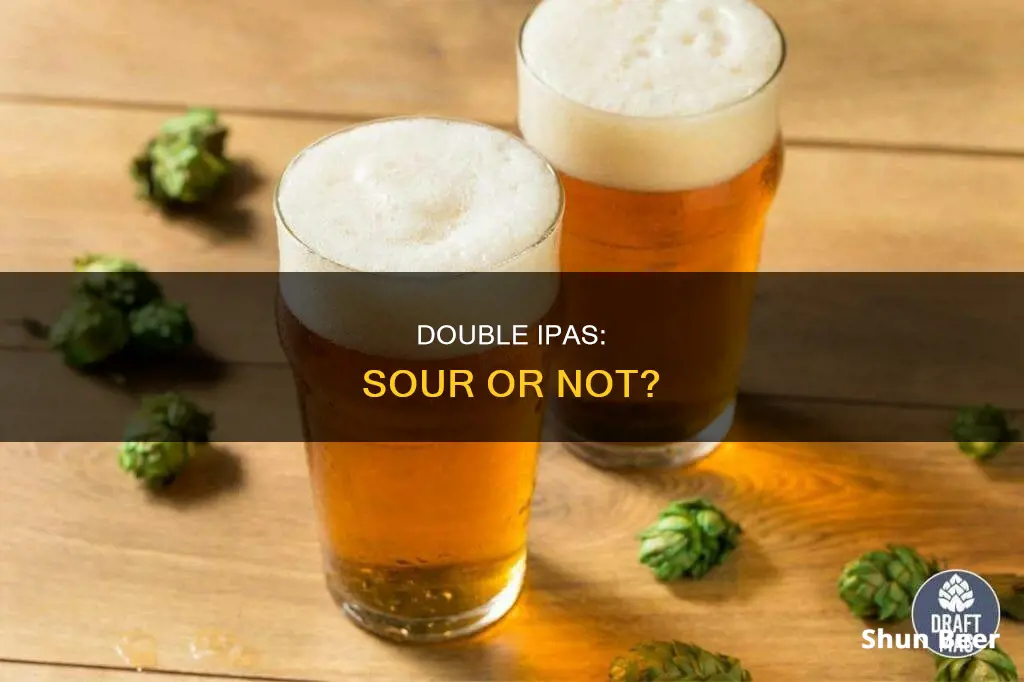
A Double IPA, also known as an Imperial IPA, is a hopped-up version of a pale ale. It has a higher alcohol content than a standard IPA, usually with an ABV range of 7-10%. On the other hand, sour IPAs are made with the addition of acid, typically through a process called kettle souring, which gives them their tartness. So, is a Double IPA considered a sour beer? Not exactly. While there may be some overlap in terms of ingredients and brewing processes, a Double IPA is primarily characterized by its higher alcohol content and intense bitterness, while a sour IPA is defined by its tartness and lower pH level. Ultimately, the two styles serve up distinct flavour profiles and drinking experiences.
| Characteristics | Values |
|---|---|
| Double IPA Alcohol Content | 7-10% ABV |
| Sour Beer Alcohol Content | Not mentioned |
| Double IPA Flavour | Hoppy, bitter, toasted, caramel |
| Sour Beer Flavour | Tart, acidic |
| Double IPA Appearance | Golden or amber colour, medium body |
| Sour Beer Appearance | Not mentioned |
What You'll Learn

Double IPAs have a higher ABV than standard IPAs
Double IPAs, also known as Imperial IPAs, are characterised by a higher alcohol content than standard IPAs. This is achieved by adding more malted grains, which increases the amount of fermentable sugars available for the yeast to convert into alcohol. The result is a stronger brew with a higher ABV (alcohol by volume).
The Brewer's Association defines a double IPA as having an ABV between 7.6% and 10.6%, while a standard IPA typically falls in the range of 5-7% ABV. To be considered a double IPA, the beer should generally have an ABV of 7% or higher, with the ideal range being between 7% and 9% ABV. Going above 9% ABV may result in a less drinkable beer.
The higher ABV in double IPAs is a result of the increased grain bill during the brewing process. More malt is added, which provides more sugars for fermentation and contributes to the higher alcohol content. This also leads to a heavier style of beer with a stronger flavour profile.
In addition to the higher ABV, double IPAs also tend to have a more intense bitterness and aroma due to the increased use of hops. The extra layering of hops promotes more bitterness, and the additional malt provides a more distinct toasted or caramel malt flavour. However, it's important to note that the perception of bitterness can vary between a classic IPA and a double New England IPA, even when they are brewed with the same quantity of hops.
The creation of double IPAs can be attributed to the experimentation and innovation in the American craft beer scene, particularly on the West Coast. The style officially hit the market in California in 1994, and it has since become a popular and well-loved variation of the timeless India Pale Ale.
The Cost of Guinness Beer in Ireland
You may want to see also

Double IPAs are hop-centric
The creation of the Double IPA is attributed to Vinnie Cilurzo of the Russian River Brewing Company, who in 1994 brewed the first Double IPA, the Inaugural Ale, at California's Blind Pig Brewing Co. He followed this up in 1999 with Pliny the Elder, brewed at Vic's Double IPA Festival, which inspired brewers to push the limits of the IPA.
Double IPAs, also known as Imperial IPAs, are essentially IPAs with a higher hop concentration. They have a higher ABV (usually over 7%) as the increased malt used to balance the hops results in a stronger beer.
Double IPAs can be dry-hopped, which is the process of steeping hops in fermenting beer instead of adding them while the liquid is boiling. This amplifies the fruity, piney, or candy-sweet notes of the hops and makes the beer smell better without adding bitterness.
Some examples of highly-rated Double IPAs include:
- Hi-Wire Brewing Big Top Production Facility Hazy Juicy Hoppy Fresh Double IPA with Citra & Strata
- Stone Brewing Stone Ruination IPA
- Lawson's Finest Liquids Double Sunshine IPA
- Burial Beer Co Perceptions of Carnage
Guinness: The Healthiest Beer Option?
You may want to see also

Sour IPAs are made using the kettle souring process
Sour IPAs are a unique blend of the bitterness of an IPA and the sourness of a sour beer. They are made using the kettle souring process, which is a quick and efficient way to brew sour beers. This process involves fermenting the beer in the presence of probiotic bacteria, typically Lactobacillus, which gives the beer its distinct sour taste.
Kettle souring is a simple technique with a few modifications to the standard brewing process. It is often completed within 24 to 48 hours and produces a unique, brightly coloured flavour profile. By adding microbes that produce lactic acid before fermentation, brewers significantly shorten the aging period needed to make a sour beer.
The first step in the kettle souring process is mashing, which is the same as in standard brewing. The already crushed grains are mashed to extract the wort, which is then collected into the brew kettle. The wort is then pasteurised by heating it for 10 to 15 minutes to kill any bacteria present. This step is crucial as the kettle souring process involves working with microorganisms, and ensuring sterile equipment and ingredients is essential to prevent contamination.
The next step is to chill the wort to a temperature range of 75 to 100 degrees Fahrenheit (24 to 35 degrees Celsius). Lactobacillus and other probiotics are acid-resistant bacteria and will not thrive in an alkaline environment, so the wort is acidified using lactic acid to create an acidic environment for the bacteria to thrive. The desired pH range is typically between 4.0 to 4.5, and this can be measured using a pH meter.
Once the wort reaches the desired pH, the lactobacillus is pitched, or inoculated, into the wort. A larger and healthier culture will lead to quicker and more effective souring. The brew kettle is then sealed airtight and wrapped with plastic wrap to rid the contents of oxygen. The waiting period begins, during which the bacteria cells increase in number and produce lactic acid, affecting the sourness of the beer.
Throughout the waiting period, the temperature and pH must be monitored regularly. The ideal temperature for the souring process is between 80 to 100 degrees Fahrenheit, and this can be maintained by insulating the kettle with an electric blanket. The pH should be measured at intervals of 6 to 8 hours, with the aim of reaching a pH reading of 3.0 to 3.5.
Once the desired pH or taste is achieved, the normal brewing process can resume. The wort is boiled to kill the remaining lactobacillus and stop the souring process. Hops can be added during or after the second boil to contribute bitterness and protect against microbes. The wort is then cooled and inoculated with brewing yeast to initiate primary fermentation.
The kettle souring process allows brewers to create sour beers with a unique flavour profile in a short amount of time, making it a popular choice for both professional and home brewers. It is a blend of art and science, and brewers can experiment with different hop combinations and fruit additions to create distinct sour beers.
The Brewing Process: Guinness Beer Filtration Techniques
You may want to see also

Sour IPAs are a relatively new style of beer
Sour IPAs also employ souring agents like lactobacillus cultures, which impart a tart characteristic to the beer. Lactobacillus plantarum is considered the best option for brewing sour IPAs due to its ability to rapidly create acidity.
The style likely emerged sometime in the 2010s. Fort Collins' New Belgium Brewing Company began brewing Le Terroir, a dry-hopped and wood-aged golden sour, in 2011. Meanwhile, the Hudson Valley Brewery, a New York-based operation known for its sour IPAs, celebrated its second anniversary in January 2019.
Sour IPAs represent more than just another IPA trend for breweries devoted to the style. It's a whole new way of approaching beer, offering an alternative sensory experience that blends the popular elements of sours and hazy IPAs.
Creating a sour IPA is a delicate process as bitter and sour flavours typically don't pair well together. Brewers have to carefully balance these contrasting flavours, which can be challenging. However, modern brewers have the advantage of using super tropical and fruit-forward hops, which can pair beautifully with the tart notes in the beer.
While sour IPAs might be a niche style, they offer a unique and experimental drinking experience for craft beer enthusiasts.
The Mystery of Grapefruit in IPAs: Fact or Fiction?
You may want to see also

Sour IPAs are made with fruit purées
Sour IPAs are a unique style of beer that combines the characteristics of an IPA with the tartness of a sour beer. While the idea of combining bitter and sour flavours may seem unappealing, the result is a surprisingly delightful beverage that offers a unique sensory experience.
Sour IPAs are crafted with a specific set of ingredients and techniques that contribute to their distinct flavour profile. One key ingredient used in their creation is fruit purées. Fruit purées add a layer of complexity, enhancing the fruity and juicy characteristics already present in IPAs. The use of fruit purées allows brewers to experiment with different flavours, creating unique and innovative sour IPAs that stand out in the crowded craft beer market.
The process of making sour IPAs involves a combination of wild yeast and bacteria. Wild yeast, such as Brettanomyces, adds a layer of earthiness to the beer. Meanwhile, bacteria like Lactobacillus and Pediococcus contribute to the sour flavour by converting sugar into lactic acid. This combination of yeast and bacteria is what gives sour IPAs their distinctive tangy taste.
Fruit purées play a crucial role in enhancing the fruity notes of sour IPAs. Brewers have a wide range of fruit purées to choose from, including popular options such as raspberry, blood orange, and tangerine. These strong and tart fruits complement the sharp flavours of sour beers, creating a well-balanced beverage. The addition of fruit purées allows brewers to showcase their creativity and develop unique flavour profiles that attract consumers seeking novel and exciting craft beers.
The versatility of sour IPAs is further highlighted by the variety of hops that can be used in their creation. While fruity and juicy hops are commonly chosen, brewers also have the option to add hops during the whirlpool process or the kettle boil, depending on their desired level of bitterness. This flexibility in the brewing process allows for experimentation, resulting in sour IPAs with distinct and intriguing flavour profiles.
In conclusion, sour IPAs are a unique style of beer that combines the characteristics of IPAs with the tartness of sour beers. Fruit purées are a key ingredient in their creation, adding complexity and enhancing the fruity notes. With a range of fruit purées, hops, and brewing techniques to choose from, brewers can create endless flavour combinations, making sour IPAs a dynamic and exciting option in the craft beer world.
Guinness Beer: Extra Stout or Draught, What's Original?
You may want to see also
Frequently asked questions
A Double IPA, also known as an Imperial IPA, is a hopped-up version of a pale ale. It has extra hops and malt, which gives it a more bitter taste and a more distinct toasted or caramel malt flavor.
Sour beers are made using a process called kettle souring, which involves adding acid to the beer, usually through the use of lactobacillus cultures.
No, a Double IPA is not considered a Sour Beer. While a Double IPA may have a more bitter taste due to the extra hops, it does not involve the addition of acid that characterizes Sour Beers.
The alcohol content of a Double IPA is typically between 7-10% ABV.
Yes, there are a few similar styles to Sour IPAs, including pastry sours, fruited sours, and wild ales.







